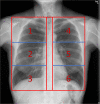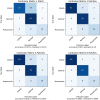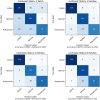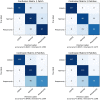New patch-based strategy for COVID-19 automatic identification using chest x-ray images
- PMID: 36406188
- PMCID: PMC9647770
- DOI: 10.1007/s12553-022-00704-4
New patch-based strategy for COVID-19 automatic identification using chest x-ray images
Abstract
Purpose: The development of a robust model for automatic identification of COVID-19 based on chest x-rays has been a widely addressed topic over the last couple of years; however, the scarcity of good quality images sets, and their limited size, have proven to be an important obstacle to obtain reliable models. In fact, models proposed so far have suffered from over-fitting erroneous features instead of learning lung features, a phenomenon known as shortcut learning. In this research, a new image classification methodology is proposed that attempts to mitigate this problem.
Methods: To this end, annotation by expert radiologists of a set of images was performed. The lung region was then segmented and a new classification strategy based on a patch partitioning that improves the resolution of the convolution neural network is proposed. In addition, a set of native images, used as an external evaluation set, is released.
Results: The best results were obtained for the 6-patch splitting variant with 0.887 accuracy, 0.85 recall and 0.848 F1score on the external validation set.
Conclusion: The results show that the proposed new strategy maintains similar values between internal and external validation, which gives our model generalization power, making it available for use in hospital settings.
Supplementary information: The online version contains supplementary material available at 10.1007/s12553-022-00704-4.
Keywords: Automatic classification; COVID-19; Chest X-Rays.
© The Author(s) under exclusive licence to International Union for Physical and Engineering Sciences in Medicine (IUPESM) 2022, Springer Nature or its licensor (e.g. a society or other partner) holds exclusive rights to this article under a publishing agreement with the author(s) or other rightsholder(s); author self-archiving of the accepted manuscript version of this article is solely governed by the terms of such publishing agreement and applicable law.
Conflict of interest statement
Conflict of interestThe authors declare that there is no conflict of interest.
Figures










Similar articles
-
Current limitations to identify covid-19 using artificial intelligence with chest x-ray imaging (part ii). The shortcut learning problem.Health Technol (Berl). 2021;11(6):1331-1345. doi: 10.1007/s12553-021-00609-8. Epub 2021 Oct 10. Health Technol (Berl). 2021. PMID: 34660166 Free PMC article. Review.
-
UBNet: Deep learning-based approach for automatic X-ray image detection of pneumonia and COVID-19 patients.J Xray Sci Technol. 2022;30(1):57-71. doi: 10.3233/XST-211005. J Xray Sci Technol. 2022. PMID: 34864714
-
COVID-19 diagnosis from chest x-rays: developing a simple, fast, and accurate neural network.Health Inf Sci Syst. 2021 Oct 12;9(1):36. doi: 10.1007/s13755-021-00166-4. eCollection 2021 Dec. Health Inf Sci Syst. 2021. PMID: 34659742 Free PMC article.
-
Chest X-ray Classification Using Deep Learning for Automated COVID-19 Screening.SN Comput Sci. 2021;2(4):300. doi: 10.1007/s42979-021-00695-5. Epub 2021 May 26. SN Comput Sci. 2021. PMID: 34075355 Free PMC article.
-
Quantitative multi-image analysis in metals research.MRS Commun. 2022;12(6):1030-1036. doi: 10.1557/s43579-022-00265-7. Epub 2022 Oct 14. MRS Commun. 2022. PMID: 36474648 Free PMC article. Review.
References
-
- Weissleder R, Lee H, Ko J, Pittet MJ. COVID-19 diagnostics in context, Sci Transl Med. 2020;12:eabc1931. 10.1126/scitranslmed.abc1931. - PubMed
LinkOut - more resources
Full Text Sources
